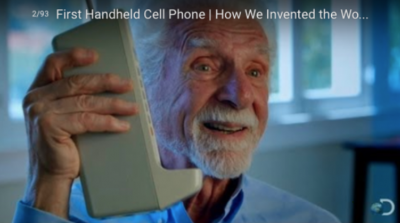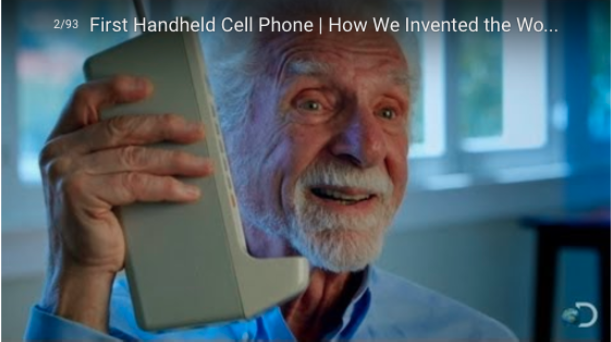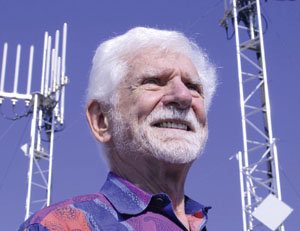Blog /
History of the Mobile Phone

Tracking the most important innovations in mobile phone technology –
Pre-mobile, when it was just a dream:
William Rae Young was a Bell Labs engineer who first suggested what ultimately became the concept behind the cellular mobile phone system. It was Young’s idea to create the hexagonal cell concept through cities so that every mobile phone user would be able to communicate from at least one cell tower through the telephone system. The system did not receive widespread adoption due to its required size and exorbitant cost. Only a few of the mega-rich citizens, in addition to James Bond, actually used them.
The first mobile telephone call was placed in St. Louis on June 17, 1946 from a telephone installed in an automobile. That was the first “car phone.”
In 1947, AT&T introduced cell phone service between New York and Boston. The phones were known as “push-to-talk” telephones. The project was approved by the FCC, but it was a massive failure due to too much interference.
While Young had what was the best idea for mobile service, it took until 1971 until AT&T formally proposed his initial idea of utilizing cells in cities. AT&T proposed Young’s idea to the FCC. Young’s idea for mobile technology would ultimately lead to the modern day mobile phone system.
mobile looks like a possibility – just a crazy one

In the early 1970’s, Motorola and Bell Labs were in a race to produce the first handheld mobile phone. That race ended when Martin Cooper, general manager of Motorola’s Communications Systems Division, made the first modern mobile phone call from handheld equipment on April 3, 1973. A patent for the technology was granted on October 17, 1973.
Cooper’s fame has certainly increased in recent years. He appeared in a series of Mazda commercials and was interviewed by 60 Minutes. Cooper’s Mazda 3 commercial appeared in Super Bowl XLVIII when Seattle thrashed Denver 43-8.
“When Martin Cooper invented the mobile phone in 1973, connectivity took a mighty leap forward,” the ad states. No doubt.
Cooper’s initial phone call was the ultimate “in your face” when he called the offices of Bell Labs and Dr. Joel Engel. In the commercial, the landline recipient of the phone call is in an office and the actor playing Cooper quips: “Guess what we just did?”
“People want to talk to other people – not a house, or an office, or a car,” said Cooper. “Given a choice, people will demand the freedom to communicate wherever they are, unfettered by the infamous copper wire. It is that freedom we sought to vividly demonstrate in 1973.”
“As I walked down the street while talking on the phone, sophisticated New Yorkers gaped at the sight of someone actually moving around while making a phone call,” added Cooper. “Remember that in 1973, there weren’t cordless telephones, let alone cellular phones. I made numerous calls, including one where I crossed the street while talking to a New York radio reporter – probably one of the more dangerous things I have ever done in my life.”

Mobile’s Early Days
Public cell phone testing began in 1977 in Chicago. Under the permission of the FCC, the Bell Telephone Company got the license in an initial partnership with AT&T.
The first mobile phone was known as “the brick”, weighing in at a hefty 30 ounces! It would take ten more years until Motorola came out with a less wieldy brick. In 1983, Motorola introduced the 16 ounce, 13-inch-tall, DynaTac 8000x phone. It took a full ten hours to charge, and when charged, it offered a mere 30 minutes of actual talk time. The DynaTac cost $3995. In the movie Wall Street, famed actor Michael Douglas used a DynaTac cell phone.
In 1988, the Cellular Technology Industry Association (CTIA) began to lay down practical goals for cellular phone providers. It recommended that TDMA technology be the standard. Today, the CTIA show attracts over 35,000 attendees to its annual trade show in Las Vegas.
Motorola rolled out the MicroTAC flip phone in 1989. It was the first commercially available flip phone. To this day, the flip phone remains the best mobile phone for denial of the infamous butt dial. For this reason, the flip phone continues to have loyal users still grasping to their feature (non-smartphone) phone.
Mass adoption of mobile phones
In 1990, mobile phones reached critical mass as subscribers topped one million for the first time ever in the United States.
The first truly pocket-sized flip phone appeared in 1996 when the Motorola StarTAC hit the market. The StarTAC was a clamshell-style phone that weighed just 3.1 ounces and was very futuristic for its time. In fact, it was said to be inspired by the popular science fiction television show Star Trek.
The Nokia 9000 Communicator was a highly innovative release in 1997, because it actually included a keyboard on the phone. The phone could send and receive faxes. It had an LCD screen and could also render web graphics in monochrome. The monochrome screen eventually gave rise to the ability for customers to customize their screens with unique graphics such as the Playboy rabbit head—then the best-selling monochrome graphic. Nokia also brought us a new pastime in 1998–playing snake on our mobile phone. Has there ever been a more basic, yet addictive, mobile phone game?
Including a camera on a mobile phone became a reality in 2000 when the Sharp JSH04 debuted in Japan. It was also the first phone to allow MMS (Multi Media Messaging). MMS allows users to take pictures and send them to friends—a common feature that we take for granted today.
Cameras are a very important part of today’s mobile technology. Did you ever notice how nobody sees UFOs any more now that we all have cameras with us all the time? The first US phones with built-in cameras were the Nokia 7650 and the Sanyo SPC-5300 in 2002. The Sanyo model had a 176×208 pixel color display. Compare that to the iPhone 6 which has 8 megapixels in its camera.
Blackberry Debuts
Canadian company Research in Motion (RIM) introduced Blackberry in 2002. Blackberry was an innovator with the introduction of its Blackberry 5810 model. This was the first mobile phone that integrated data devices. For the first time, consumers had their email and personal digital calendar with them at all times. The Palm Treo 180 and Microsoft Pocket PC soon followed to go after the same market–the on-the-go business person.
The Blackberry was life-changing for business people, perhaps in a bad way. The line between office hours and off hours was forever blurred. It was the perfect business phone. The Blackberry made you completely connected to the office, and to the boss, like never before.
With mobile technology, you’re never the leader for very long unless you are constantly innovating and consistently creating a better product than the one you offered just a few months ago. As innovative as the Blackberry was, there was something even bigger on the horizon.
Motorola hit pay dirt in 2004 with the introduction of its slim RAZR phone. The RAZR was just 0.54 inches thin and appealed to the public’s demand for smaller devices. Motorola sold over 130 million RAZR phones. It had a nice run, though touch screen technology eventually replaced it.
Prior to 2007, most of us used feature phones that operated on the Symbian operating system. These phones allowed you to talk, text and browse the web, but they didn’t offer much customization. In addition, consumers relied on the apps that came preloaded on the feature phones. There was a race in industries like the ringtone business to get “on the deck”, a platform completely controlled by each carrier.
Apple goes mobile
Apple. The biggest game changer of them all debuted in 2007 when Apple began marketing the iPhone. The iPhone was the world’s first touchscreen smartphone and was incredibly easy to navigate for the non-technical user. Its screen resolution and ability to navigate via touch was a showstopper. The iPhone quickly showed just how clunky Blackberry and previous smartphones and flip phones were.
iPhone didn’t get everything right with its debut smartphone. For instance, it missed simple copy and paste technology on its initial offering, but with its updates to its hardware and software, it continues to fix and improve its product every year.
As the iPhone gained market share, businesses began to take notice. That’s because their website needed optimization for the smaller screen of the mobile phone. Moreover, the iPhone was revolutionary in the sense that the development community started customizing software with innovative apps. These apps could utilize the built-in functions of the phone itself such as the camera or the GPS to offer a smooth and streamlined user experience.
Apple’s iOS was the first operating system to offer downloadable apps. Initially, if you wanted an iPhone, you had to use Cingular (now AT&T Wireless) as your carrier. iPhone enabled Cingular to close the gap on market leader Verizon and helped it earn hundreds of thousands of new subscribers. This included the highly coveted upscale consumers who could afford the high price tag of iPhone. In addition to traditional phone service, Cingular also sold large amounts of data plans to its new customers.
Apple shook the mobile world once again in 2010 when it introduced the iPad. The iPad used mobile technology, but made it optional to be able to make a phone call from it.
Google Enters the Arena
Google purchased Android in 2005 and in November 2007, it unveiled its Google Android operating system. It then introduced its HTC Dream phone in October 2008. As opposed to iPhone, Google released Android across many handset manufacturers, not granting exclusivity to any one carrier. Android systems were cheaper than iPhones, thus opening up the ability to own smartphones to a larger group of customers. Because of its ability to work on multiple carriers, Android also attracted consumers that wanted a smartphone, but didn’t want to change providers.
With two major competitors in the operating system market, publishers needed to develop apps for both the iTunes and Android Marketplace. They also needed to develop apps for Blackberry, but most publishers soon after dropped developing apps for it when Blackberry failed to innovate beyond its initial corporate email success and began losing subscribers.
Today’s mobile phone
Nowadays, you see people glued to their phones no matter where they are. They’re talking, texting, sending emails, checking what their friends are doing on Facebook, looking for love on dating apps and yes, surfing the web. They’re researching products and services, reading the news and buying gifts. There isn’t anything you can’t do on your phone, it seems like.
That means that if you’re in the business of making money – and who isn’t? – you have to embrace the technology. Put us to work earning money for you on the mobile phone.




